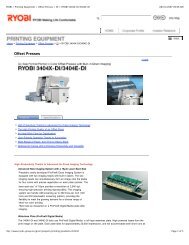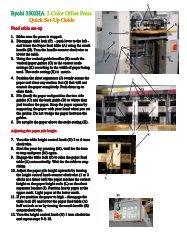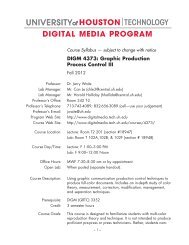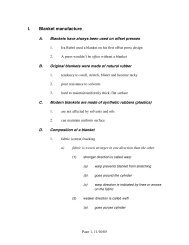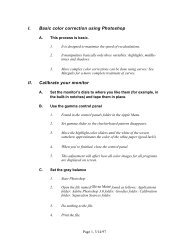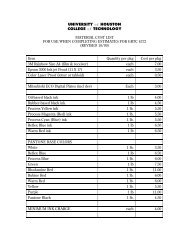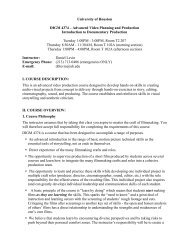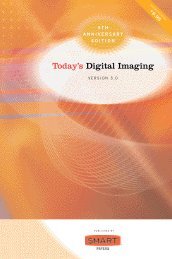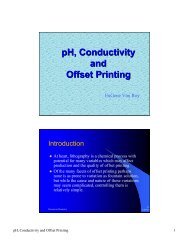PRESS QUALITY CONTROL DEVICES
PRESS QUALITY CONTROL DEVICES
PRESS QUALITY CONTROL DEVICES
Create successful ePaper yourself
Turn your PDF publications into a flip-book with our unique Google optimized e-Paper software.
<strong>PRESS</strong> <strong>QUALITY</strong> <strong>CONTROL</strong> <strong>DEVICES</strong><br />
I. Categories of Quality Control Devices<br />
A. Dampening System devices<br />
B. Inking System devices<br />
C. Sheet Control System devices<br />
D. Printing Unit devices<br />
E. Paper QC devices<br />
F. Ink QC devices<br />
G. Print Quality QC Devices<br />
H. Devices to maintain QC in finishing<br />
II. Dampening System devices<br />
A. Refrigerated circulator (deJidas page70)<br />
1. Cleans contaminants from system (ink, paper dust, and so on)<br />
2. Refrigerates liquid<br />
a. Maintains alcohol level (alcohol evaporates at a lower temperature than water) — automatically<br />
replenishes alcohol level to present percentage using built-in hydrometer.<br />
b. Helps prevent evaporation of water (evaporation leads to a stronger solution in terms of conductivity<br />
and pH.)<br />
3. Maintains constant fluid level in fountains<br />
B. pH meter (deJidas page 77)<br />
C. Conductivity meter (deJidas page 78)<br />
III. Inking System Devices<br />
A. Durometer (deJidas page 63-64)<br />
1. measures 0–100˚. 100˚ would be an inflexible material such as cast iron<br />
2. Forms are softer (lower number) than distributer roller.<br />
3. A roller’s durometer will increase about 10–15˚ during its lifetime<br />
a. commercial deglazing solution can often reduce a roller’s durometer.<br />
B. Air Curtin<br />
1. A device that directs streams of low-pressure air against a strategically located roller to evaporate<br />
excess water.<br />
IV. Sheet Control System Devices<br />
A. GATF Side-Guide Marks (deJidas page 277) (also use real example)<br />
1. Use for image-to-sheet registration checks<br />
2. Test of side-guide misregister (show on board)<br />
3. Test of front-stop misregister (show on board)<br />
B. Register marks<br />
1. Use for image-to-image registration check on multi-color press.<br />
2. Use for image-to-image registration check on single-color press.<br />
V. Printing Unit devices<br />
A. Micrometer for measuring the thickness of paper, plates, and packing sheets.<br />
B. Paper micrometer<br />
1. has wider jaws to prevent crushing of paper that a machinist’s micrometer can cause<br />
C. Cady gauge (deJidas page 150)<br />
1. Micrometer with wide throat for measuring the thickness of blankets other than at the edges<br />
D. Packing Gauge (deJidas page 151)<br />
1. Only give a brief overview—a major topic in Press II.<br />
E. Torque wrench (deJidas page 180)
1. To apply proper tension to blanket<br />
VI. Paper QC devices<br />
A. Likely to be found in pressrooms<br />
1. Hygroscope (deJidas pages 208–209)<br />
a. Tests moisture content of the inside of a stack of paper.<br />
2. Thermometer—check for consistent temperature in press room<br />
3. RH meter<br />
a. to check humidity-level of room<br />
b. Refer to chart of page 210.<br />
4. Antistatic bar<br />
a. Used in feeder or feedboard to decrease chance of static-charged paper from sticking to the feedboard.<br />
b. Used in delivery to neutralize static in paper that might cause sheets to stick to one another in the<br />
delivery exacerbating setoff.<br />
c. Can be combined with air blast or vacuum to clean dust particles from paper before sheets are printed.<br />
5. Micrometer<br />
a. Special thickness gauge for paper and plates has a wider jaw than a machinist’s micrometer to prevent<br />
compressing paper, blankets, plates, etc.<br />
b. Bench micrometers (also known as blanket thickness gauges) can be used to measure the thickness<br />
of paper in various places over the entire sheet.<br />
c. Some micrometers now have digital displays.<br />
B. Devices found in paper manufacturers but not likely in a printing plant.<br />
1. Brightness meters (IGC page 3)<br />
a. Brightness is the percentage of 457nm (blue) light that is reflected from a paper.<br />
b. Brightness is not whiteness, which is the equal reflection of red, green, and blue light.<br />
c. A paper that is bright does not appeared yellowed.<br />
d. Brightness should be uniform because it affects the contrast, color values and attractiveness of a<br />
printed product.<br />
2. Colorimeter<br />
a. Measures the color of paper, ink and printed ink.<br />
b. Important test for uniformity of a paper’s color from batch to batch and during production run.<br />
c. Results are given in the standard CIELAB color space (X,Y,Z; L, a, b) values where X,Y, and Z are<br />
standard colors combined to create other colors, L is the luminosity of a particular color, a is the<br />
amount of a red–green hue channel in a color, and b is the amount of blue–yellow hue channel.<br />
3. Glossmeter<br />
a. Gloss is a measure of a sheet’s shininess or lustrousness. When paper is very flat, the light rays<br />
reflecting from it are reflected as parallel rays—a mirror-like action called specular reflection.<br />
b. Gloss is the amount of light reflected from the paper when the angle of illumination equals the angle<br />
of reflection.<br />
c. Specular gloss is measured at 75˚ The paper is illuminated with light at a75˚ angle and measured at<br />
an angle of 75˚ by a photocell. Shiny papers reflect from 15%–75%.<br />
d. Contrast gloss is measured at 57.5˚ in the same way that specular gloss is measured. Contrast<br />
gloss measurements are used for low-gloss papers.<br />
4. Opacimeter<br />
a. Opacity is the property of paper that obstructs light transmission and the show-through of printing.<br />
b. Insufficient opacity and the resultant excessive show-through reduce printing contrast and detract<br />
from printing quality.<br />
c. Light striking a sheet can:<br />
• reflect back
• absorb into<br />
• pass through (transmitted)<br />
d. If transmitted light is in the form of parallel rays, the paper is translucent<br />
e. The more light that is absorbed or scattered, the higher the paper’s opacity.<br />
f. Factors influencing opacity are:<br />
• composition (ingredients)<br />
• brightness (the brighter the paper (more blue-white) the higher the opacity)<br />
• color<br />
• basis weight (thicker are more opaque)<br />
• coating increases opacity<br />
g. Opacity is tested by placing a single sheet of paper over a highly reflective surface. Light is shined<br />
on the paper and the amount that passes through the sheet and is reflected back from the reflective<br />
sheet is measured. The more light that returns the less opaque the paper.<br />
• A sheet that allows 98% of the light to return is 2% opaque.<br />
• A completely opaque paper is 100% opaque and no light is reflected through it.<br />
h. A quick visual check of a sheet’s opacity can be done by printing a solid area on a sheet (perhaps<br />
done with an ink proof press) and inspecting the show-though on the reverse side.<br />
i. Certain grades of paper tend to be more opaque than others (papers designed for book printing are<br />
more opaque than those designed for letterheads).<br />
j. The addition of clay or other pigment into the paper increases opacity.<br />
5. Spectrophotometer<br />
a. measures the color of paper by giving a wave-length by wavelength analysis of its reflected light.<br />
b. a curve depicting the paper’s reflection of each individual wavelength of visible light is prepared<br />
c. reflectivity of each individual wavelength is expressed as a percentage ratio of the same wavelength<br />
reflected by an ideal white reflectance standard.<br />
d. These devices are similar to those employed by paint companies to color-match paints<br />
e. Inkmakers also use spectrophotometers.<br />
6. Absorbency Testers<br />
a. Absorbency is the ability of paper to take up fluids<br />
b. inks must penetrate paper to properly adhere<br />
c. A Penetration Volumeter is used to check absorbency oil<br />
• liquid is allowed to penetrate into paper<br />
• as the liquid penetrates the paper, it drives out the air contained in the paper<br />
• the amount of air displaced is measured to give a measure of the absorbency<br />
7. Densometer—Also Porosity Meters<br />
a. Measures how long a given volume of air takes to pass through the pores of the paper.<br />
8. Expansimeter<br />
a. Measures dimensional stability<br />
b. No paper is completely dimensionally stable—they all will change size with changes in moisture content.<br />
c. Paper is designed to have best dimensional stability at 35–50% humidity. Humidity levels higher than<br />
50% can cause the “built-in stresses” designed into the paper to relax, thus allowing dimensional<br />
change.<br />
d. A known length of paper is held under light tension at 50% humidity for a given length of time. The<br />
RH is changed to 65% and the elongation is measured.<br />
e. This test can also be used on materials other than paper, such as stripping base or film.<br />
9. Coefficient-of-Friction Testers<br />
a. Friction is the resistance of a material to slide over itself.<br />
b. A paper’s friction is not usually important during printing, but may be important for finished products<br />
such as paper bags or corrugated cartons (so they don’t slide around easily).
c. The coefficient-of-friction is measured by determining the critical angle at which a sample slides<br />
down a plane.<br />
10. Hydrostatic Testers<br />
a. Measure of water resistance of paper and paperboard.<br />
b. Some papers may need to resist water (such as a printed paper plate) while others may need to<br />
absorb water (such as paper used to print paper napkins)—mention Hallmark’s gravure plant.<br />
c. The B.F. Perkins Hydrostatic Tester measures and indicates the resistance of materials to water penetration.<br />
11. Linting Testers<br />
a. Lint originates from loosely bonded surface fibers of paper.<br />
b. Causes hickies and other print-quality defects.<br />
c. Do not confuse with picking, which is caused by excessive ink tack.<br />
d. Linting Testers determine the extent to which paper has a tendency to release dust, particles of<br />
coating, and paper fibers during printing.<br />
12. Moisture Meters<br />
a. Determines moisture content of the paper<br />
b. Paper’s moisture content is more important to the papermaker than the printer—the printer is more<br />
concerned about the balance between the sheet’s moisture content and the RH of the pressroom.<br />
c. The printer uses a hygroscope to measure a paper’s moisture content, while the papermaker uses a<br />
moisture meter.<br />
d. Changing the moisture content of paper affects other properties of the paper as well<br />
• bursting and tensile strength is low when paper is either too dry or too moist.<br />
• tear resistance is higher when paper is more moist.<br />
• fold strength is higher when paper is more moist.<br />
• elongation (deformation) increases when paper is more moist.<br />
• stiffness decreases when paper is more moist.<br />
• Paper with less than 35% humidity cannot dissipate static electricity and becomes “magnetic”.<br />
e. Uneven distribution of moisture in paper causes wavy- or tight-edged paper.<br />
13. Picking Testers<br />
a. Although picking is caused by the ink’s tack, reducing tack results in less-sharp printed images or<br />
improper trap (when reducer is added to ink), or increased costs (if press is slowed down).<br />
b. Paper should be able to withstand the normal tack of the inks to be used on a given press.<br />
c. Surface strength is the ability of paper to withstand perpendicularly applied force without rupturing.<br />
High surface strength prevents picking.<br />
d. Surface strength is tested using a series of waxes, each with a progressively stronger adhesive<br />
power. The weakest wax to pull fibers out of a given stock demonstrates the pick-resistance of the<br />
paper.<br />
14. Smoothness or Roughness Testers<br />
a. Smoothness affects the appearance of papers—smooth look shiny while rough look dull.<br />
b. Test by using a sheet of the given paper as somewhat of a “gasket.” See how long it takes for a<br />
given amount of air to leak by the “gasket.”<br />
15. Adhesive Tester<br />
a. Ability of a paper to stick to itself or another surface by means of adhesives.<br />
b. Important for labels<br />
c. Instrument measures the amount of force required to peel-off a given paper bonded to surfaces<br />
using various adhesives.<br />
16. Basis Weight Testers<br />
a. Measure a single sheet of basic size paper on a specially designed scale that is graduated in units<br />
relative to 500 sheets of the same paper stock (scale automatically measures the weight of one<br />
sheet by 500 to arrive at reading).
17. Bursting Strength Tester<br />
a. Bursting strength is the amount of pressure required to rupture paper when pressure is uniformly<br />
applied to one of its sides.<br />
b. Commonly measured with a Mullen Tester.<br />
c. Bursting strength is a general indicator of toughness and stamina for paper.<br />
d. Bursting strength is most important for cartons, which must comply with shipping standards.<br />
18. Compression Testers<br />
a. Compressibility is a paper’s capacity to be squeezed on a flat surface and return to its prior state.<br />
b. Printing with a blanket compresses the paper—it must be able to snap-back to its original width—<br />
known as resiliency.<br />
c. Soft paper does not rebound when compressed. Hard paper does.<br />
d. Hard papers resist indentation from a pen, pencil, type or printing plate (Letterpress prints better<br />
with soft paper—prints into the paper rather than onto it).<br />
e. Using a tool similar to a roughness or smoothness tester, air is allowed to leak out when a sheet of<br />
the paper is used as a seal. Softer paper will leak slower than harder paper because the paper compresses<br />
to form a better seal.<br />
19. Folding Endurance Tester<br />
a. Folding endurance is the number of double folds that a paper will withstand before it breaks under<br />
specified conditions.<br />
b. Paper has a greater folding endurance when folded against the grain.<br />
c. A strip is clamped under tension between a spring-loaded jaw and an oscillating folding head. The<br />
paper is folded back and forth an exact number of degrees. The number of such folds the paper can<br />
endure is the folding endurance.<br />
d. Certain applications require a very high folding endurance (menus, reference books, maps,<br />
envelopes)<br />
e. For many applications, folding endurance should not decrease as paper ages (permanent records).<br />
20. Puncture Testers<br />
a. Paper’s resistance to perforation<br />
b. Force required to puncture a sheet of paper with a triangular pyramid point, under controlled conditions,<br />
is measured.<br />
21. Stiffness Tester<br />
a. Stiffness is the ability of a sheet to support its own weight (important for file folders, index cards<br />
postcards, bank checks, and music paper that must be held without paper leaning over)<br />
b. Low stiffness is required for other printed products such as napkins and book paper (which needs to<br />
allow pages to be turned).<br />
c. The force required to bend a sheet of paper to a specified angle is measured. The higher the result,<br />
the stiffer the paper.<br />
22. Tearing Strength Testers<br />
a. Internal tearing resistance is the amount of force required to tear paper through a fixed distance<br />
after the tear has already been started.<br />
• Important for durable papers used for maps, envelopes, and file folders.<br />
• Papers with high internal tearing resistance include cover, bristol, tag, kraft, wrapping<br />
and bond papers.<br />
b. Edge tearing resistance is the resistance of paper to tear from the edge.<br />
• Very important for papers subjected to high stress, such as those used for web presses.<br />
c. Tensile-strength testers are used to test tearing resistance. The amount of force needed to tear a<br />
given sheet is measured. In most cases, the tear is started before the test is applied.<br />
23. Tensile strength testers<br />
a. Tensile strength is the amount of stress a paper will withstand before it breaks.<br />
b. Before breaking, paper elongates (stretches) before it breaks. The elongation is measured and
expressed as a percent of the sheet’s original length.<br />
c. Papers have greater tensile strength in the grain direction as compared to the across-the-grain direction.<br />
d. A strip of paper is held in two jaws. One jaw is gradually moved away from the other under increasing<br />
force. The maximum elongation before the paper tears is an indicator of the tensile strength.<br />
e. Tearing and tensile tests vary primarily in that tearing tests are done to papers in which a tear has<br />
already been started—tensile strength is done to untorn sheets.<br />
f. A special type of tensile strength test is done after the paper has already been saturated with water.<br />
It is called the wet tensile breaking strength. Wet strength is the percent ratio of wet-to-dry tensile<br />
breaking strength.<br />
VII. Ink QC devices<br />
A. Colorimeters and Spectrophotometers (see paper)<br />
B. Dispersion Testers<br />
1. evaluate the dispersion attained in premixing of ink.<br />
2. A measured sample of ink is drawn across a glass plate by a hard steel gauge. Eventually, scratches will<br />
appear in the ink film deposited on the glass (caused by the particles of pigment).<br />
3. Note is made where 4 scratches appear and where 10 scratches appear. The greater the distance<br />
between these two points, the wider the range of coarse particles (and the poorer the ink has been dispersed)<br />
C. Drying-time tester<br />
1. Such tests are not completely accurate because they do not consider press variables such as amount of<br />
water fed or the pH of the dampening solution or paper.<br />
2. A drying print is put into contact with clean paper at short time intervals. The drying time can be measured<br />
by the length of time it takes for no set-off to occur.<br />
D. Ink-film applicators<br />
1. Used to check the undertone of ink.<br />
2. Thwing-Albert Quick Peek Tester applies a uniform drawdown of ink to a selected substrate.<br />
3. Helps press operators check the color match of ink before it is placed into the fountain.<br />
4. Also used to compare printed ink films with the test.<br />
E. Ink Film Thickness Gauge<br />
1. Helps press operator measure and control how much ink is being carried<br />
2. Thicker films result in longer drying time<br />
3. An indicator of the quality of the ink—the thicker the film of ink required to produce a given density, the<br />
less pigment.<br />
4. A spherical, spring-loaded lens is forced through the wet layer of ink to contact the substrate. The ink<br />
leaves a circular spot on the lens. The diameter of the spot is measured and plotted on a chart to determine<br />
ink-film thickness.<br />
F. Fineness of grind tester (similar to dispersion test, but performed after ink is ground on the mill)<br />
1. Proper pigment dispersal (particles are ground down into very small particles) results in better press performance.<br />
2. Poor grinding results in piling, weaker colors, streaking, plate fill-in, scumming, and unnecessary wearing<br />
of plates and rollers.<br />
3. A fineness of grind gauge is a flat steel block that has two flat-bottomed grooves in its surface that vary<br />
in depth from near zero at one end to maximum at the other end of the block.<br />
4. To make the test, place a small amount of ink in the deep end of the grooves and drawn the sample<br />
toward the shallower end using a straight-edge scraper.<br />
5. Eventually furrows or scratches will appear in the grooves (caused by particles).<br />
6. The closer to the shallow end of the groove the that furrows or scratches appear, the better the ink has<br />
been ground.<br />
G. Mixing Scales<br />
1. Required to properly mix PANTONE colors.
2. Available in either balance-beam or electronic versions.<br />
H. Tack Testers (Inkometer)<br />
1. Tack is the resistance of a thin film of ink to split (stickiness).<br />
2. Tack must be controlled to prevent picking and also to achieve proper trap.<br />
I. Viscometers (many types of tests available)<br />
1. Resistance to flow<br />
2. Paste inks have high viscosity (offset/letterpress) while fluid inks have low viscosity (gravure, flexography)<br />
3. In one test, a rod is coated with ink. The rod is positioned to slide through an opening of slightly larger<br />
diameter than the rod. The length of time it takes for the rod to move a specified distance is proportional<br />
to the viscosity of the ink (the longer it takes, the higher the viscosity).<br />
4. Fluid ink viscosity is measured using a Zahn cup. The length of time that a premeasured amount of ink<br />
takes to flow though an orifice (various diameters of orifices are available) the higher its viscosity.<br />
J. Abrasion (scuff) testers<br />
1. Can the printed ink film resist scuffing?<br />
2. A weighted strip of unprinted paper is moved over a printed test specimen of the same paper through a<br />
specified arc for a predetermined number of strokes.<br />
3. Both surfaces are examined for ink rub (smear).<br />
K. Exposure Resistance Testers<br />
1. Tests printed ink film’s resistance to light and weather conditions.<br />
2. Sample is placed into controlled atmosphere and tested with regard to fading, dissolving, and other<br />
weather-related conditions.<br />
VIII.Print-Quality QC Devices<br />
A. Color Control Bars (refer to page 290 of deJidas)<br />
1. Patches for solid layers of each process color (the six-color also has space for 2 spot colors)<br />
2. Patches of overprints of each of the process colors (y+m=r; y+c=g; m+c=b) to evaluate trap.<br />
3. Patches of specified-size screen tints to evaluate dot gain<br />
4. Star Targets to evaluate doubling and slur (briefly describe)<br />
5. Overprints of specified-size screen tints to evaluate gray balance.<br />
6. Press manufacturers often supply their own color bars that match ink key/wedge configuration for a specific<br />
press.<br />
B. Magnifiers<br />
1. Need about a 20X magnifier for checking registration<br />
2. Need 50X or above for checking dot shape and size.<br />
C. The GATF QC strip (refer to page 290 of deJidas)<br />
1. A solid stripe of each process color with a patch of alternating printed and blank diagonal lines.<br />
2. The strip on the OK sheet is placed adjacent to the same strip on the current press sheet. The stripe<br />
provides a check for:<br />
a. ink film thickness (lines grow fatter if there is too much ink)<br />
b. ink-water balance (scum shows up readily)<br />
c. image quality (sharpness of diagonal lines and intersection between solid area and lines)<br />
D. The GATF Dot Gain and Slur Gauge (refer to page 290 of deJidas)<br />
1. Dot gain is checked by a series of numbers created by finely spaced horizontal lines of differing thicknesses<br />
on a coarse-dot background.<br />
a. A change in which the position that the number blends into the background indicates dot gain or<br />
sharpening.<br />
2. Slur target is the word “slur” spelled-out using horizontal lines on a background of vertical lines of the<br />
same width.<br />
a. Slur only affects around-the-cylinder size of dots/lines<br />
b. Thus, slur will cause the horizontal lines to thicken, but not the vertical ones.
c. Result is the word “slur” standing-out from the background.<br />
E. The GATF Midtone Dot Scale (refer to page 291 of deJidas)<br />
1. A minor change in dot size in the mid-tone portions of a printed halftone causes a marked effect on the<br />
perceived tonal range of the halftone.<br />
2. The target consists of several crosses with 5 dots (one in the center and one in each cell formed by the<br />
cross). A number is printed below each cross.<br />
3. If the press gains 1%, the dots and the cross touch at the 1% location; if the press gains 10%, the dots<br />
and corss touch at the 10% position.<br />
F. Reflection Densitometer<br />
1. The basic QC device in the pressroom. Depending on model it may measure:<br />
a. Reflection density of each of the process colors.<br />
b. Dot area<br />
c. Trap<br />
d. Hue error and grayness<br />
2. Reflection density<br />
a. The target density and acceptable tolerance range should be established for each job based upon<br />
the quality level (basic, good, premium and showcase) and the accepted color OK’d on the OK<br />
sheet.<br />
b. Density numbers are not fixed numbers, but may vary due to inks, paper, and image.<br />
c. Typical targets might be: K=1.60; C & M=1.40; Y=0.90.<br />
d. Density, as read in the color bars, must remain consistent across the press sheet and throughout the<br />
press run within tolerances specified in 2a above.<br />
3. Dot area<br />
a. Too much or too little ink or pressure cause printed dot sizes to vary from the dot sizes recorded on<br />
the film and plate.<br />
b. All presses gain to some extent due to the rubber blanket.<br />
c. Plus or minus tolerances must be specified in advance.<br />
4. Trap<br />
a. The amount of ink transferred to a previously printed ink film can be equal to or greater than that<br />
transferred to paper. The amount of transfer is referred to as Trap.<br />
b. The percent trap is calculated as follows:<br />
Percent trap =<br />
DOP − D1<br />
D<br />
2<br />
× 100<br />
Where D 1 is the reflection density of the first down ink, D 2 is the density of the second-down ink,<br />
and D OP is the density of the overprint.<br />
b. Our densitometer calculates this value automatically (give demo)<br />
c. Wet trap seldom exceeds 90% (as calculated with the above equation) for red and blue, but values<br />
above 90% are possible with green<br />
• 80–90% are most common<br />
• Less than 75% trap is unacceptable<br />
d. High trap is important, but not as important as the printed sheet matching the OK’d sheet.<br />
5. Hue error and grayness<br />
a. Hue error is the departure of a process ink from its ideal hue.<br />
b. Hue error is calculated by measuring the density reading of a given patch of the color in question<br />
using red, green, and blue filters.<br />
c. Hue error is calculated as follows:
Hue error =<br />
M<br />
H<br />
−<br />
−<br />
L<br />
L<br />
Where M is the medium density reading, L is the lowest density reading, and H is the highest density<br />
reading.<br />
d. Grayness is the freedom of a process color from gray.<br />
e. Grayness is calculated as follows:<br />
Grayness = L H<br />
f. The lower the grayness of a process color, the higher is purity.<br />
6. Print contrast ratio<br />
a. High print contrast is an indication of good shadow contrast in a reproduction. Higher print contrast<br />
is related to higher print quality.<br />
b. Print contrast is calculated as follows:<br />
Print contrast =<br />
DS<br />
− D75 × 100<br />
D<br />
S<br />
where D S is the density of a solid (including paper) and D 75 is the density of a 75% tint (including<br />
paper).<br />
G. Color Viewing booth (can be part of press console)<br />
1. To prevent misunderstandings<br />
2. Press and area where press check is OK’d must have the same lighting<br />
3. Standard color viewing conditions:<br />
a. Color temperature of 5,000˚K<br />
b. Color rendering index of 90–100 (how well a light source simulates daylight)<br />
c. Level of print illumination 204.4±43.6 footcandles (measured with a light meter)<br />
d. Geometry of print illumination — no glare (10–15K˚ different than viewing plane)<br />
e. Surround—matte, neutral gray (Munsell N8)<br />
4. Lamps need to warm up for 15–30 minutes before an accurate reading is possible.<br />
5. Lamps and surrounding area need to be cleaned frequently<br />
6. Lamps last only a specified number of hours before color temperature begins to change.<br />
7. Extraneous light can alter the controlled lighting of the booth. Install 5000˚ lamps in all light fixtures in<br />
the color viewing room and fixtures near the color console of a press.<br />
H. Automated Process Control devices<br />
1. Press consoles (deJidas page 295)<br />
2. Plate scanners — scans plate to preset fountains (deJidas page 298)<br />
3. Scanning Densitometer — scans printed sheet to measure and analyze color control bars. Each control<br />
patch is compared to tolerances. Ink-key adjustments can then be made. (deJidas page 298)<br />
IX. Devices to maintain QC in finishing department<br />
A. Fold marks<br />
B. Trim Marks<br />
C. Signature collating marks<br />
D. Bar code (UPC Code) check
E. MICR check



